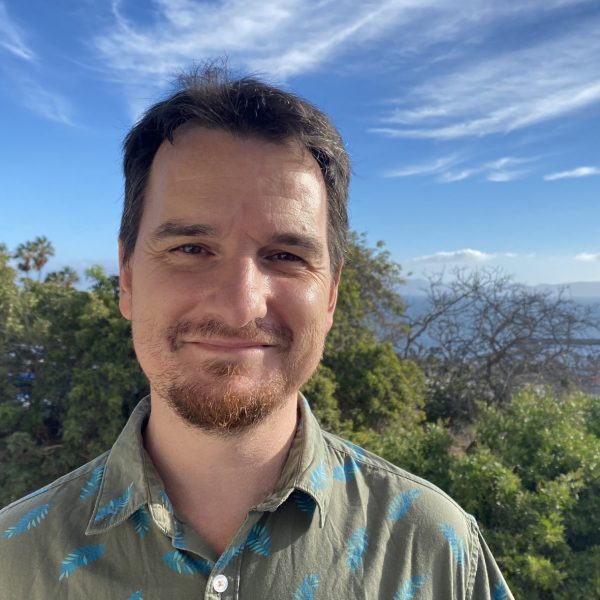Meet Our Staff: Jose Luis Abella-Gutiérrez

At the beginning of his career, Jose collaborated with artisanal fishery communities in Spain and Mexico to evaluate the interactions between seagrass ecosystems and human activities. Later, his research work centered on paleoclimate reconstructions —analyzing natural archives as marine sediments, tree rings, and bivalve shells— and he became interested in the recurrence of drought and wet periods at decadal to centennial timescales, how these long-term hydroclimate events influenced past civilizations, and how they must be considered in water resource management in our present-day society.
Education
B.A. in Marine Biology, University of La Laguna, Canary Islands, Spain.
M.S. in Marine Ecology, CICESE, Baja California, Mexico.
Ph.D. in Paleoceanography, CICESE, Baja California, Mexico.
Postdoctoral Fellow, Laboratory of Tree-Ring Research, University of Arizona, AZ, USA
Climate
During his Ph.D., Jose become interested in the connections between the Pacific ocean variability and Western North American droughts and has dedicated his last years of research to better understanding ocean-atmosphere interactions at decadal to centennial timescales.
Soon after his Ph.D. Jose was granted a postdoctoral grant by the CAZMEX consortium to study Links between the North American Monsoon and Gulf of California variability at Decadal to Multidecadal Timescales in the Laboratory of Tree-Ring Research (University of Arizona). He was hosted by Connie Woodhouse and took advantage of his stay in the most renowned Tree-ring laboratory to learn the basics of dendroclimatology.
Jose went back to the Tree-ring Lab as a Postdoctoral Research Associate working on the NSF project led by Bryan Black, Multi-proxy Reconstructions of North Pacific Decadal Variability from Bivalve Mollusks and Trees to find links between North Pacific sea surface temperature and Western North America precipitation using bivalve and tree-ring records.
Currently, he is involved in the NSF project led by ESI director Jay Banner, Regional aridity shifts in response to abrupt global change events during the last deglacial, a high-resolution observation-model approach. In this study, Jose will contribute his experience as a paleoclimatologist to evaluate variability in the West-East Texas aridity gradient during previous abrupt glacial-interglacial climate changes.
Water
As ESI program coordinator he is part of the team that coordinates the Texas Water Research Network (TWRN) dedicated to connecting researchers from Texas universities, stakeholders, and communities. Jose took part in the initial steps of a similar network in Baja California (Red Interinstitucional de Expertos en Recursos Hídricos de Baja California) during his stay in Mexico.
Jose will contribute his experience working with trees to better understand when water infrastructure failure begins in the city of Austin and how municipal water evolves once it is transmitted to the hydrologic system in the NSF project led by the ESI director Jay Banner, Urban Watershed Evolution – Novel temporal perspectives on the hydrologic impacts and positive unintended consequences of failing municipal infrastructure.
Ocean
At the beginning of his research career, Jose was granted to study the impact of traditional fisheries on endangered species associated with seagrass ecosystems in the Mediterranean. Later, he was granted by the Mexican government to continue his research on seagrass ecology in Mexico, addressing questions related to nutrient incorporation and pathways in the trophic web using stable isotopes.
He gain knowledge in biogeochemistry during his years in the Stable Isotope laboratory as a technician and Ph.D. student and collaborated in the cruises and analysis of samples from the Gulf of Mexico after the Deepwater Horizon Spill Oil. Later, he worked as a Research Associate in the Gulf of Mexico Research Consortium (CIGoM) for two years analyzing sediment cores and managing data to develop regional biogeochemical baseline analysis from the Gulf of Mexico.
Most of his outreach activities were developed during his years in Mexico (and in Spanish). He collaborated with Science Clubs (Clubes de Ciencia) to develop and teach an introduction to geophysics course to students from High school to University. He also collaborated with his former institution (CICESE) in outreach events such as Science night (La noche de Ciencias) and collaborated with Mexican science communication journals.
Jose developed a science blog dedicated to explaining the basics of paleo sciences (http://paleociencia.weebly.com/)
He collaborated with the Tree Ring Research Laboratory to translate to Spanish the Hall exhibition audio guide.
[9] Cheung, A., S. Sandwick, X. Du, J. Abella-Gutiérrez, R. Vachula, T. Herbert, B. Fox-Kemper. J. C. Herguera. Middle to Late Holocene sea surface temperature and productivity changes in the northeast Pacific. Paleoceanography and Paleoclimatology, 37, e2021PA004399. https://doi.org/10.1029/2021PA004399
[8] Abella-Gutiérrez, J., R. Touchan, J. Boehm, K. Bolles, A. M. Treviño, K. Swarts, L. Uliana, and D. M. Meko, 2021. Oceanic influence on Chiricahua Mountains drought observed in a 383-year Douglas fir reconstruction. Tree-Ring Research, Vol. 77(2), pp 63-73. doi:10.3959/TRR2020-7
[7] Abella-Gutiérrez, J., J. C. Herguera, P. G. Mortyn, C. S. Kelly, and M. A. Martínez-Botí, 2020. Multidecadal climate variability in the southern region of the California Current System during the last 1800 years. Paleoceanography and Paleoclimatology, 35: e2019PA003825. doi:10.1029/2019PA003825
[6] O’Mara, N. A., A. H. Cheung, C. S. Kelly, S. Sandwick, T. D. Herbert, J. M. Russell, J. Abella-Gutiérrez, S. G. Dee, P. W. Swarzenski, and J. C. Herguera, 2019. Subtropical pacific ocean temperature fluctuations in the common era: multidecadal variability and its relationship with Southwestern North American Megadroughts. Geophysical Research Letters, 46: 14662– 14673. doi:10.1029/2019GL084828
[5] Abella-Gutiérrez, J. and J.C. Herguera (2016) Sensitivity of carbon paleoproductivity in the Southern California Current System on different time scales for the last 2 ka. Paleoceanography, 31, 953–970, doi:10.1002/2015PA002872.
[4] Manent-Sintes, P. and J. Abella-Gutiérrez (2007). Contribución al conocimiento sobre el crecimiento del pejerrey Atherina boyeri Risso, 1810 en el norte de Menorca (islas Baleares, Mediterráneo occidental). Boletín Instituto Español de Oceanografía 23 (1-4): 115-119.
[3] Manent-Sintes, P. and J. Abella-Gutiérrez (2006). Population biology of Palaemon adspersus (Decapoda, Caridea) in Fornells Bay, Balearic Islands, western Mediterranean. Crustaceana 79 (11): 1297-1308.
[2] Manent-Sintes, P. and J. Abella-Gutiérrez (2005) Catálogo preliminar de la ictiofauna asociada a diferentes hábitats de una bahía somera y protegida en la reserva marina del norte de Menorca, Mediterráneo occidental. Boletín de Historia Natural de Baleares Vol 48 (87-94).
[1] Manent Sintes, P. and J. Abella-Gutiérrez (2005). Primera cita de Pontinus kuhlii (Bowdich, 1825) en aguas de Menorca. Boletín de Historia Natural de Baleares Vol 48 (39-42).
